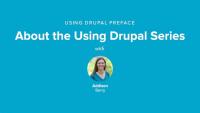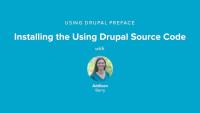This page is archived
We're keeping this page up as a courtesy to folks who may need to refer to old instructions. We don't plan to update this page.
This series is the first of thirteen series to cover the material in the O'Reilly Media book Using Drupal. This short introductory series will give an overview of how the series will work, and how you can line up the book with the video lessons. We also walk through the steps to work with the source code that we provide to go along with the chapters.
See our guide Using Drupal Book by O'Reilly Media to access all of our tutorials related to this book. Each series covers a chapter (or appendix).
The Using Drupal series of lessons walks through the O'Reilly book, Using Drupal, written by Angie Byron, Addison Berry, and Bruno de Bondt. We use the second edition, which covers Drupal 7. The book starts off with taking a look at Drupal Core and then works through various case studies using a wide range of contributed modules from the Drupal project.
The video series follows along with what's in the book, so if you have the book, the videos are really great supplemental material. Even without the book, you’ll get the full lessons here in the videos.
This series is intended for people who have worked with the web and understand how a website gets delivered, and in particular, how to get a website onto a web server so that people can actually see it and use it. The rest of this introductory series we have here will look at how the book relates to the video series we're going to be creating, and how you can use those 2 together.
Additional resources
In this lesson, we are going to see how the book relates to each of the series we have, and how each of the individual series are organized. We will end up with thirteen series to cover the entire book. Then we will take a look at how you should use the videos with the book. If you don't have the book, not to worry, as the book would only act as supplementary material to the video lessons. You don't need the book to successfully follow these series. If you do have the book however, we want to make sure you understand how the lessons and book relate to each other.
Additional resources
Using Drupal comes with source code intended to be used throughout the lessons to make following the lessons much easier. In this lesson we're going to take a look at what that source code provides for us, where we can get a copy of, and how to use it. We'll go through the installation process, as well as see how we can switch between chapters in the source code without destroying work you've done on previous chapters. It is important to note that using the source code is very important if you want the lessons to match what is in the lessons. Drupal modules can change a lot over time, and the source code is designed to exactly match what is covered in the lessons. Once you've learned the basics of a chapter by working through the source code, you can upgrade your modules and explore the differences in newer versions, with the base understanding you've gained from the lesson.
Warning: Since this Drupal code is several years old, you must use PHP 5.3. PHP 5.4 or higher will not work. You will need to make sure your server is using PHP 5.3 in order to use this code properly. Many all-in-one servers, like WAMP, MAMP, and XAMPP provide older versions of PHP and a way to switch back and forth between versions.


